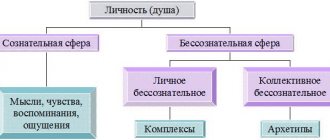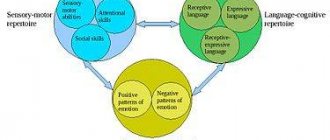Personality theories in psychology are a set of theoretical and practical material about the nature of individual development. Scientists all over the world put forward their hypotheses and assumptions about the typology of individual characteristics, about the sources of character formation, about the processes that dominate the personal structure. Some theories, both foreign and domestic experts in the field of psychology, have received wide publicity and have become the most in demand, which requires a more detailed study of them.
Psychodynamic theory of personality
For foreign psychology, and for the whole world in general, the name of Sigmund Freud became associated with classical psychoanalysis. It was the Austrian psychologist who put forward the sensational theory that the main driving factor of a person is instinctive sexuality or libido. According to the theoretical material of S. Freud, the classification of personality structure is as follows:
- ID or It is the totality of the unconscious. This is where sexual and aggressive impulses are present, i.e. The driving force of a person is to receive pleasure.
- EGO or Self – conscious cognitive and executive functions. This structure of personality traits contains everything a person knows about the real world. It is the Ego that regulates all unconscious processes and tames the ID and Superego.
- Superego or Super-ego - contains social and moral norms, moral and cultural values.
The theoretical aspects of psychoanalysis are based on the fact that the sexual component is given to people from birth. As a person grows older and becomes more excited, he or she seeks release, while unresolved childhood conflicts become prerequisites for the formation of psychosexual types.
Social concept of personality formation
Supporters: D. Locke, J.B. Watson, L.S. Vygotsky A.S. Makarenko and others.
Social theory considers a person as a “white sheet of paper”, on which, thanks to the correct education of society (society), one can write a masterpiece, regardless of what nature has endowed him with. There is a certain classical term for joining a person to the system of society - “socialization”. Socialization is entry into society, and it is carried out in stages.
The socialization of the individual begins in the first years of a person’s life, with his mastering of social norms and orders, with the beginning of distinguishing his role in society. For example: “I am a boy, son, brother...”. Or: “I am a girl, a daughter, an older or younger sister, a first-grader...”. And also the roles of the people around him: relatives and close relatives, educators/teachers, acquaintances and strangers. Further, each person gradually determines his own worldview, vocation, way of life, etc. It is important to understand that the socialization of the individual accompanies us throughout life, but its most important stages must be completed on time. If some aspects in raising a child are missed by parents or educators/teachers, then a young, immature personality may develop problems with socialization. For example, teenagers who were not given career guidance classes at school age may subsequently experience a number of specific difficulties in determining their professional direction in this life. And this burden will grow every year, like a “snowball” over many years of unsuccessful searches for oneself and one’s place in this life.
Analytical theory K.G. Cabin boy.
The theory of personality traits according to K.G. Jung contains the main and main psychological factor, which is based on innate aspects transmitted genetically from parents, i.e. Primary character templates or “archetypes” are inherent in a person from birth. Subsequently, the scientist developed the theory, highlighting three conceptual directions in the structure:
- The collective unconscious contains all the accumulated human experience or innate cultural heritage. This structure reflects thoughts and feelings that are characteristic of all humanity.
- The individual unconscious implies the presence of complexes and experiences that were forgotten or suppressed, but subsequently become the driving force of the individual for life.
- Individual conscious – regulates a person’s conscious activity through self-awareness, memories and sensations.
Also K.G. Jung described the main orientations of the ego - extraversion (direction to the external world) and introversion (the individual's focus on the internal).
Biological concept of personality formation
Supporters: C. Darwin, I. Muller, S. Hall and others.
According to the biological concept, a person is a kind of “treasury of genetic information” received by him from both parents and embedded in his maternal and paternal ancestors. In this case, the prenatal period also plays an important role: that is, the lifestyle and emotions of the mother during pregnancy. Of course, it is foolish to deny the importance of all of the above, but it should be clearly understood that we do not inherit character traits or motivation to achieve goals from our forefathers. We only receive a certain basis for development, which we must use. So, for example, from birth, a person can receive the makings of a mathematician or physicist and a pronounced choleric type of temperament. But whether a given person can be a good teacher or scientist and control, for example, innate hot temper, corresponding to the type of his temperament, depends on his upbringing and formed worldview. In addition, it is impossible to accurately determine in advance whether a child will inherit certain inclinations from his parents. And besides this, numerous studies of the so-called “Mowgli children” (human children who from an early age grew up in conditions of extreme social isolation - without contact with people, as a rule, having been saved from death by packs of wild animals) have shown that if isolation from society occurred in the first 3-6 years of life, then these children will practically not be able to master human language, meaningful communication with other people, or even just basic upright walking, despite subsequent years spent in human society. This is clear proof of the fact that the full development of a child’s personality is impossible without his being in society, where he has the opportunity to adopt from society certain skills and experience that humanity has developed over thousands of years, let’s move on to social theory:
Cognitive theory
There are only two questions in the cognitive theory of personality:
- What's happening now?
- What does the future hold?
It is these two dilemmas that torment a person all his life, according to the founder J. Kelly. A person perceives the world according to an individual internal model of behavior, which is called a constructor and is interpreted through the influence of intellectual processes. To put it briefly, according to the psychologist, only similar constructors are able to interact normally with each other.
Individual theory according to Alfred Adler
Psychologist A. Adler believed that human life strives for superiority and improvement, the individual tries to overcome childhood fears, complexes and feelings of inferiority. Within the framework of this scientific theory, the individual develops his own, original lifestyle, which is focused on the desire to be first, to be the best. At the same time, the individual has only three main tasks - friendship, love and work. Depending on the importance of each of them, the level of activity and the typology of the individual are manifested - the controlling, receiving, avoiding and socially useful type.
Activity theory
In Russian psychology, the most popular theory was the activity theory, which was developed by several scientists, and the founder was S.L.
Rubinstein. According to the developments of scientists, only the direction of activity becomes the main one in the system of existential and existential properties of a person. The structure of an individual, in accordance with activity theory, consists of the direction of actions, abilities, characteristics and self-control. A conscious subject directs all his own efforts to satisfy his goals and ambitions.
Modern theories of personality in foreign and domestic psychology try to find commonality in each individual. Biological and social in this case are considered the main parameters through which individual characteristics can be interpreted. For example, a comparison of some theories clearly traces the relationship between congenital, social and individual factors.
The table indicates that the main issue in all psychological theories is recognizing the essence of the human personality. It is the problem of human interaction and development that occupies the minds of psychologists and scientists around the world.
Abstracts For You
Introduction Chapter 1. History and modern theories of personality 1.1 Theory of personality 3. Freud 1.2 Theory of personality of A. Adler 1.3 The concept of personality of G. Eysenck 1.4 Psychology of personality of Jung 1.5 Theory of personality of A. G. Maslow Chapter 2. Classification and content of the latest theories of personality 2.1 Classification the latest theories of personality 2.2 Model of personality K.K. Platonov 2.3 Theory of E. Bern 2.4 Theory of personality A.N. Leontyev Conclusion List of used literature
Introduction
The term "personality" has different meanings. The science of personality - personology - is a discipline that seeks to lay the foundation for a better understanding of human personality through the use of various research strategies. Modern personality psychology, being a scientific discipline, transforms speculative reasoning about human nature into concepts that can be confirmed experimentally.
Personality is, first of all, an abstract concept that combines many aspects that characterize a person: emotions, motivation, thoughts, experiences, perceptions and actions. The conceptual meaning of personality covers a wide range of internal mental processes that determine the characteristics of human behavior in various situations. Theories of personality vary widely, so it is almost impossible to simply assign a conceptual definition to the word “personality.” Within psychology, there is no single generally accepted meaning - there are as many meanings as there are psychologists and personality theories that solve this problem.
1. History and modern theories of personality
1.1 3. Freud's theory of personality
Today in psychology there is no single generally accepted theory of personality, but there are a great many different theories, concepts and models of personality that have significant influence and a large number of supporters.
There are theories of personality that are known not only to psychologists, but are also popular among the general population. One of these concepts is Z. Freud's psychodynamic theory of personality. According to Freud, personality is formed by three structural components: id (it), ego (me) and superego (super-ego). The id sphere is the instinctive core of personality. Powerful instincts located in the id sphere require their implementation and determine (directly or indirectly) the behavior of the individual. In general, the functioning of the id sphere is subject to the pleasure principle. In Freud's psychodynamic theory, two basic instincts are distinguished - the sexual instinct, also interpreted as the life instinct (libido, eros), and the destructive, destructive instinct, interpreted as the death instinct (mortido, thanatos). This form of human behavior, such as aggression, is considered in this concept as an instinctive form of behavior, as a manifestation of the destructive instinct of the individual.
Psychodynamic concept 3. Freud has as many opponents as supporters. Perhaps this is the theory about which the largest number of extreme, radical value judgments are expressed - from enthusiastic acceptance to unconditional rejection. In its most extreme form, the rejection of psychoanalysis by scientific psychology was perhaps formulated by the world-famous psychologist P. Fresse, who once stated that psychoanalysis is faith, and in order to believe, you must first “get on your knees.”
1.2 A. Adler’s theory of personality
A. Adler's personality theory is known as individual personality theory or individual psychology. This theory is also traditionally attributed to the psychoanalytic direction (Adler is one of Freud’s first and favorite students), although in fact most of the provisions of individual psychology developed as antitheses of Freud’s theory. A. Adler's theory, paradoxical as it may sound, in its spirit and basic conceptual provisions can be considered as a harbinger and forerunner of modern humanistic psychology.
The essential foundations of Adler's theory are associated with such concepts as 1) fictitious finalism; 2) the desire for superiority; 3) feelings of inferiority and compensation; 4) social interest; 5) lifestyle; 6) creative “I”.
Fictitious finalism. According to Adler, the main goals of a person, i.e. those goals that determine the direction of an individual’s life are fictitious goals - their correlation with reality cannot be verified. But, despite the fictitiousness, it is the presence of such final goals that is the real stimulus for human activity and explains his behavior.
Some people, for example, may structure their lives around the idea that hard work and a little luck can achieve almost anything. This statement (according to Adler) is just a fiction, since many of those who work hard do not get what they deserve. Other examples of fictitious beliefs that can influence a person's life are the following: “honesty is the best policy,” “all men are created equal.” The belief that the righteous will go to heaven and the wicked will go to hell undoubtedly also influences human behavior. And this belief is also an example of fictitious finalism. The final goal, being a fiction, a kind of ideal idea, despite this, plays the role of a real incentive, a motive for a very specific sustainable human behavior.
Individual psychology strongly insists that psychological phenomena cannot be understood without the principle of finalism. Reasons, forces, instincts, motives cannot be the basis for explanation. Only final goals can explain human behavior.
Striving for excellence. Initially, Adler called the desire for power as the ultimate goal to which all people strive. He later abandoned the term "will to power" in favor of the term "desire for superiority." The desire for superiority is not limited to achieving high social status or leadership. The pursuit of excellence is a general desire for growth, a movement in a bottom-up direction. Thus, the desire for excellence can be expressed in a huge number of different ways, and each person realizes this desire in his own way.
Feelings of inferiority and compensation. A feeling of inferiority is a feeling that arises in connection with the experience of one’s own social or psychological failure. It arises from a feeling of defectiveness or imperfection in any area of life. The feeling of inferiority is inherent in almost all people. Essentially, at the core of everything people do is the desire to overcome feelings of inferiority and to strengthen a sense of superiority. Therefore, feelings of inferiority are not a sign of pathology. On the contrary, it is the cause of human improvement. At the same time, the feeling of inferiority under certain circumstances (for example, associated with improper upbringing) can intensify and reach an abnormal level.
In this case, they talk about the formation of an inferiority complex. Adler identified three types of suffering experienced in childhood, which can lead to the development of an inferiority complex: inferiority of an organ, excessive care, and rejection by parents. The desire to compensate for inferiority leads a person to development - either in the area in which inferiority is felt, or in another. As a classic example of compensation for organ deficiency, one can recall Demosthenes, who suffered from a stutter as a child and later became one of the greatest orators. However, in certain cases, compensation may give way to overcompensation, as a result of which development may take an abnormal path and lead to the formation of a compensatory superiority complex.
1.3 G. Eysenck’s concept of personality
G. Eysenck's concept of personality has become widespread in psychology. It identifies two dimensions of personality: introversion-extraversion and neuroticism-stability. These two dimensions (or factors) are independent of each other. Each of the poles of these personality dimensions represents a kind of supertrait, since, according to Eysenck, each of them is based on a combination of several component traits. In addition, each supertrait (for example, introversion) is not a discrete quantitative indicator, but a continuum of a certain extent. Therefore, in Eysenck's theory, the term “type” is used regarding supertraits.
The extroverted type is characterized by the personality's orientation towards the surrounding world. Such people are characterized by: impulsiveness, initiative, flexibility of behavior, sociability, constant desire for contacts, craving for new experiences, relaxed forms of behavior, high motor and speech activity. They easily respond to various proposals, “get excited”, take on their implementation, but can just as easily give up what they started, taking on a new business.
The introverted type characterizes the personality’s focus on oneself, on the phenomena of one’s own world. Such people are characterized by low sociability, isolation, and a tendency to introspection and reflection. Before taking on anything, they analyze the conditions, situation, task; tend to plan their actions. The external manifestation of emotions is under control, but this does not indicate low emotional sensitivity; rather, the opposite is true.
Over the years of the existence of this concept, a huge amount of research has been carried out around the world, the purpose of which was to identify differences between types. It has been empirically established that:
• extroverts are significantly more tolerant of pain than introverts;
• extroverts pause more during work to chat and drink coffee than introverts;
• introverts prefer theoretical and scientific activities, while extroverts tend to prefer work related to people;
• introverts feel more alert in the morning, while extroverts feel more alert in the evening; accordingly, introverts work better in the morning, and extroverts work better in the afternoon;
• introverts are more likely to admit to the practice of masturbation than extroverts; but at the same time, extroverts have sexual intercourse at an earlier age, more often and with a larger number of partners than extroverts.
Much later after Eysenck described extraversion and introversion, he introduced another dimension into his theory - psychoticism.
Thus, at present, Eysenck’s theory distinguishes not two, but three orthogonal (independent) dimensions of personality. People with a high degree of expression of such a super trait as psychoticism are self-centered, impulsive, indifferent to others, prone to antisocial behavior, have difficulty communicating with people and do not find understanding from them, are characterized by conflict and inappropriate emotional reactions.
1.4 Jung's personality psychology
Jung considered the study of the psyche to be the science of the future. For him, the urgent problem of humanity was not so much the threat of overpopulation or nuclear disaster as the danger of a mental epidemic. Thus, in the fate of humanity, the decisive factor is the person himself, his psyche. For Jung, this "decisive factor" is focused in the unconscious psyche, which is the real threat; “The world hangs on a thin thread and this thread is the human psyche.”
The idea of psychic energy, self-regulation, and compensation is closely connected in analytical psychology with the classification of “psychological types.” There are several different types. They refer to innate differences in temperament, an integral combination of enduring psychodynamic properties manifested in activities that cause individuals to perceive and respond in specific ways. First of all, we should distinguish between two stable types: extrovert and introvert.
An extrovert is characterized by an innate tendency to direct his psychic energy, or libido, outward, connecting the energy carrier with the outside world. This type naturally and spontaneously shows interest and pays attention to the object - other people, objects, external manners and landscaping. An extrovert feels best—what is called “at ease”—when he deals with the external environment and interacts with other people. And he becomes restless and even sick, finding himself alone in a monotonous, monotonous environment. Maintaining a weak connection with the subjective inner world, the extrovert will be wary of meeting it and will strive to underestimate, belittle and even discredit any subjective requests as selfish.
An introvert is characterized by the tendency of his libido to rush inward, necessarily connecting psychic energy with his inner world of thought, fantasy or feeling. This type pays significant interest and attention to the subject, namely his internal reactions and images. An introvert interacts most successfully with himself and at a time when he is freed from the obligation to adapt to external circumstances. An introvert of his own and immediately withdraws into large groups.
1.5 Personality theory A.G. Maslow
Maslow laid down the basic principles of humanistic psychology, proposing as a model of personality a responsible person who freely makes his life choices. Avoiding freedom and responsibility does not make it possible to achieve authenticity. It is inappropriate to focus your attention on a detailed analysis of individual events, reactions, experiences; each person should be studied as a single, unique, organized whole.
Maslow believed that we should move away from the practice of studying neurotic personalities and finally focus our attention on healthy people, because it is impossible to understand mental illness without studying mental health. The main theme of human life is self-improvement, which cannot be revealed by studying only people with mental disorders.
Man is by nature good, or at least neutral. Each contains potential opportunities for growth and improvement. All people of the fence have creative potentials, which for the majority fade away as a result of “cultivation”. The destructive forces in them are the result of unsatisfaction of basic needs.
Man is a “desiring being” who rarely and briefly achieves complete satisfaction. All his needs are innate, or instinctoid. He has no powerful instincts left in the animal sense of the word, he has only their rudiments, remnants that easily perish under the influence of education, cultural restrictions, fear, disapproval. Authentic self is the ability to hear these weak, fragile inner voices-impulses.
The hierarchy of needs, according to Maslow, is the following sequence: physiological needs, i.e., to satisfy the needs of the body; in safety, security and protection; in involvement, i.e. belonging to a family, community, circle of friends, loved ones; needs for respect, approval, dignity, self-esteem; in the freedom necessary for the fullest development of all inclinations and talents, for the realization of selfhood, self-actualization. A person must first satisfy the lower needs in order to be able to satisfy the needs of the next level.
Satisfying the needs located at the base of the hierarchy provides the opportunity to recognize the needs of higher levels and their participation in motivation. True, individual creative individuals can demonstrate their talent despite serious social problems that prevent them from satisfying the needs of lower levels. Some people, due to the characteristics of their biography, can create their own hierarchy of needs. In general, the lower the need is located in the hierarchy, the stronger and more priority it has. Needs can never be satisfied on an all-or-nothing basis; a person is usually motivated by needs on several levels.
All human motives can be divided into two global categories: deficit (or D-motives) and growth motives (or existential, B-motives). D-motives are persistent determinants of behavior, contributing to the satisfaction of deficiency states (hunger, cold, etc.). Their absence causes disease. D-motivation is aimed at changing unpleasant, frustrating, and stressful conditions.
Growth motives, also called meta-needs, have distant goals related to the individual’s desire to actualize his potential. They enrich life experience, broaden horizons, not reducing, as in the case of D-motives, but increasing tension. Metaneeds, unlike deficit needs, are equally important and are not ranked in order of priority. Examples of meta-needs are the need for integrity, perfection, activity, beauty, kindness, truth, uniqueness. Most people do not become metamotivated because they deny their deficit needs, which stifles personal growth.
Chapter 2. Classification and content of the latest theories of personality
2.1 Classification of the latest personality theories
Recently, many different theories have emerged that describe personality. We can say that almost every psychologist has his own theory, which is either completely independent or based on another “well-known” theory. The most famous theories of recent times are associated with the names: K.K. Platonova, E. Berna, A.N. Leontyev. The meaning of Platonov’s theory is that personality consists of individual components (personality orientation, experience, characteristics of mental processes, biopsychic properties), which in the process of interaction will determine human behavior. E. Berna believes that in a person there are simultaneously several types of personality behavior, each of which is activated under certain conditions. Leontyev argues that a person’s personality depends on the “alloys” of innate and acquired reactions, which manifest themselves to varying degrees. The theories of these scientists will be discussed more specifically below.
Thus, when analyzing new theories of personality, we can say that some of them are a product of pure psychology (Platonov, Berne), while others are more related to a fusion of genetics and psychology (Leontiev).
2.2 Personality model K.K. Platonov
In the personality model of K.K. Platonov, which is known as the dynamic functional structure of personality, distinguishes four procedural-hierarchical substructures of personality. In this case, the subordination of lower and higher substructures is set. The main substructures of personality are 1) personality orientation, 2) experience, 3) features of mental processes, 4) biopsychic properties. In turn, each of these substructures consists of a number of components that K.K. Platonov calls “substructures of substructures.” The orientation of a person includes beliefs, worldview, ideals, aspirations, interests, desires. Experience includes habits, skills, abilities and knowledge. The substructure of “features of mental processes” is sensation, perception, memory, thinking, emotions, will, attention. Biopsychic properties include temperament, gender and some age characteristics.
In addition, abilities and character are superimposed on all substructures of personality. All substructures differ from each other in the degree of representation of the social and biological in them, the specificity of their development and formation in the process of life, as well as their correlation with a specific level of psychological analysis.
2.3 E. Bern's theory
According to Dr. Berne, his theory arose when he observed changes in behavior, the focus of his attention became stimuli such as words, gesture, sound. These changes included facial expression, voice intonation, speech structure, body movements, facial expressions, posture and demeanor. It was as if there were several different people within the personality. At times one or other of these inner personalities seemed to control the patient's entire personality. He noticed that these different inner selves interacted with other people in different ways and that these interactions (transactions) could be analyzed. Dr. Byrne realized that some transactions have ulterior motives, and the individual uses them as a way to manipulate others in psychological games and extortion.
He also discovered that people behave in predetermined ways, acting as if they were reading a theater script. These observations led Berne to develop his remarkable theory called transactional analysis, or TA for short.
Transaction is a unit of communication. People in the same group will inevitably talk to each other or otherwise show their awareness of each other's presence. This is called a transaction incentive. The person to whom the transactional stimulus is addressed will say or do something in response. This is called transactional reaction.
As a rule, transactions follow each other in a certain sequence. This sequence is not random, but is planned by society, the real situation or personal characteristics.
The main goal pursued by E. Bern is to study a person, analyze the nature of his communication, teach him to use words, thoughts, intonations, expressions in relation to the goals of communication, help a person in his ability to analyze his words and actions, constantly comprehending them the true essence and their perception by the interlocutor.
TA, whose founder was E. Berne, is a system of group psychotherapy, where the interaction of individuals is analyzed from the point of view of three main states of the “I”.
E. Bern believed that each person has his own life scenario, the model of which is outlined in early childhood. In accordance with their life scenario, people play various games, which basically fill the entire life of mankind.
The advantage of E. Bern's concept also lies in the fact that it aims to form a sincere, honest, benevolent personality.
2.4 Personality theory A.N. Leontyev
Speaking about the individual and personality, Leontyev notes that, studying a special class of life processes, scientific psychology necessarily considers them as manifestations of the life of a material subject. In cases where we mean an individual subject (and not a species, not a community, not a society), we say an individual or, if we also want to emphasize its differences from other representatives of the species, an individual.
The concept of “individual” expresses the indivisibility, integrity and characteristics of a particular subject that arise already at the early stages of life development. The individual as a whole is a product of biological evolution, during which not only the process of differentiation of organs and functions occurs, but also their integration, their mutual “coordination.”
An individual is, first of all, a genotypic formation. But the individual is not only a genotypic formation; its formation, as is known, continues in ontogenesis, during life. Therefore, the characteristics of an individual also include properties and their integrations, which develop ontogenetically. We are talking about the emerging “alloys” of innate and acquired reactions, about changes in the substantive content of needs, about the emerging dominants of behavior. The most general rule here is that the higher we climb the ladder of biological evolution, the more complex the life manifestations of individuals and their organization become, the more pronounced the differences in their generated and acquired lifetime characteristics become, the more so, so to speak, individuals are individualized.
Leontyev explains that he started with the concept of the individual only because in psychology it is used in an overly broad sense, leading to a failure to distinguish between the characteristics of a person as an individual and his characteristics as a person. But it is precisely their clear distinction, and, accordingly, the underlying distinction between the concepts of “individual” and “personality” that constitutes a necessary prerequisite for the psychological analysis of personality.
Our language well reflects the discrepancy between these concepts: we use the word “personality” only in relation to a person, and, moreover, starting only from a certain stage of his development. We don't say "animal personality" or "newborn personality." No one finds it difficult to talk about an animal and a newborn as individuals, about their individual characteristics. We are not seriously talking about the personality of even a two-year-old child, although he exhibits not only his genotypic characteristics, but also a great many characteristics acquired under the influence of the social environment; By the way, this circumstance once again testifies against the understanding of personality as a product of the intersection of biological and social factors.
The concept of personality, just like the concept of an individual, expresses the integrity of the subject of life; personality is not made up of pieces. But personality is a holistic formation of a special kind. Personality is not an integrity determined genotypically: one is not born as a person, one becomes a person. That is why we do not talk about the personality of a newborn or the personality of an infant, although personality traits appear at the early stages of ontogenesis less clearly than at later age stages. Personality is a relatively late product of the socio-historical and ontogenetic development of man. S.L. wrote about this, in particular. Rubinstein.
Personality is a special human formation, which can no more be deduced from his adaptive activity, just as his consciousness or his human needs cannot be deduced from it. Like a person’s consciousness, like his needs, a person’s personality is also “produced” - created by social relations into which the individual enters in his activities. The fact that at the same time some of his characteristics as an individual are transformed and change is not the cause, but the consequence of the formation of his personality.
The main task is to identify the actual “formative” personalities, this highest unity of man, changeable, just as his life itself is changeable, and at the same time preserving its constancy, its self-identity. After all, regardless of the experience a person accumulates, of events that change his life situation, and finally, regardless of his physical changes, he as a person remains the same in the eyes of other people and for himself. He is identified not only by his name, he is also identified by the law, at least to the extent that he is held responsible for his actions.
Thus, there is a well-known contradiction between the obvious physical, psychophysiological variability of a person and his stability as an individual. This raised the problem of “I” as a special problem in personality psychology. It arises because the traits included in the psychological characteristics of a person express what is clearly changeable and “discontinuous” in a person, i.e. that which is precisely opposed by the constancy and continuity of his “I”.
Leontyev talks about an approach to personality, which is based on the category of objective human activity, an analysis of its internal structure: its mediation and the forms of mental reflection generated by it.
This approach, from the very beginning, makes it possible to give a preliminary solution to the question of what forms a stable basis for personality, on which depends what exactly is included and what is not included in the characteristics of a person as a person.
Conclusion
Today in psychology there is no single generally accepted theory of personality. However, there are theories that have significant influence and a large number of supporters. One of these concepts is Z. Freud's psychodynamic theory of personality. A. Adler's personality theory is known as individual personality theory, or individual psychology.
This theory also traditionally belongs to the psychoanalytic direction, although in reality most of the provisions of individual psychology developed as antitheses of Freud's theory. G. Eysenck's concept of personality has become widespread in psychology, in which two dimensions of personality are distinguished: introversion - extraversion and neuroticism - stability.
In general, at present there are many theories of personality that are developing within such areas as psychoanalysis, neo-Freudianism, cognitive-behavioral approach, humanistic psychology, and structural-typological direction.
List of used literature
- Gippenreiter Yu.M. Introduction to general psychology. - M, 2004.
- General psychology: Textbook / ed. R.H. Tugushev and E.I. Garbera. – M.: Eksmo, 2006.
- Rozin, V.M. Psychology: Science and Practice: Textbook. – M.: RSUH, Omega-L, 2005.
- Robertson R. Introduction to Jung's psychology. — Rostov-on-Don, 2001.
- Rogov E.I. General psychology. - M, 2002.
- Tikhomirov, O.K. Psychology: Textbook / ed. O.V. Gordeeva. – M.: Higher Education, 2006.
- Hall K., G. Lindsay G. Theories of personality. - M, 2003.
Was it useful to you? Tell your friends!
I like






